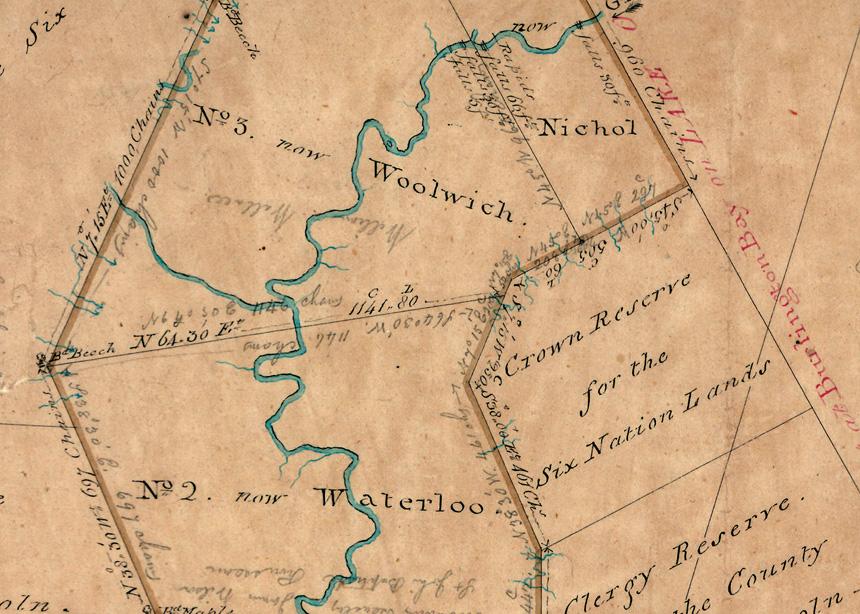A most promising possibility for a tangible response by churches to past injustice in the Six Nations Grand River lands conflict came from a conversation I had after the monthly meeting of the Haudenosaunee Council at Onondaga Longhouse on Saturday, March 3, 2007. At this meeting, Mennonite Central Committee Ontario introduced me as Community Liaison for the Aboriginal Neighbours South Program. I explained to the Council my plans to educate the churches about our Six Nations lands.
After this meeting, I sat across the dining hall table from Rick Hill, a Tuscarora, artist and Haudenosaunee knowledge keeper. Rick asked me, “Do the churches pay taxes?” I knew he was referring to property taxes, and I said, “No.” He replied, “Good. Then they are not part of the system.” He then surprised me by saying, “Wouldn’t it be great if Six Nations could have a spiritual covenant with the churches? [The churches] could acknowledge Six Nations jurisdiction over their lands and pay a token lease payment. They could continue their spiritual work and if they ever de-commissioned, the land could revert back to Six Nations.”
This conversation was burned into my memory, and I have tried to foster this dialogue ever since.
This spiritual covenant could be made in the same spirit as the original treaties recorded in wampum belts by the Haudenosaunee traditional community. Six Nations' original intention to lease their excess lands in the Haldimand Tract could also be fulfilled and the historic land injustice could be partially corrected.
The church could lead the way in a courageous act of justice, and be the conscience of Canada to pressure the government to follow suit for more comprehensive reparations.
Discussions began about this matter, and there is real interest on the part of the individual pastors and church members and Christian organization leaders. The challenge will be for the churches and organizations to build consensus.
Homeowners have also responded to this proposal by asking, “What if a thousand (or a hundred) of us homeowners had a spiritual covenant with Six Nations and paid a lease payment to Six Nations?”
The deep problem is with the willingness of the powers-that-be to allow or make this happen. Six Nations stands ready to receive a just recompense. The colonial land title system, on the other hand, is resilient against the changes Indigenous justice demands. Church lawyers are reticent as well. The call to the churches is to be the conscience of Canada and not the chaplains of empire.
When I shared this Spiritual Covenant with Churches in cities across Canada, people have come up to me asking, “How can we do this here?” My response has always been, “Find the closest Indigenous community to your church and begin dialogue.” Indigenous people want more than “land acknowledgements” that mean nothing tangible to them.
A paradigmatic story
The story is told of a Mennonite farmer who came to the Six Nations people near Brantford in the early years after Mennonites moved to the Grand River Valley land of Six Nations. He brought with him his lease payment for his lands in the Waterloo area. The Six Nations representative asked the farmer how the season was, and the farmer replied that it had been difficult. He was asked if he had seed for next year and grain for bread. The farmer said, “No. All I have is this lease payment of grain.” Mennonites are remembered by Six Nations as hard-working people of their word. The Six Nations representative said, “Take this back for bread for your family and seed for next year. You can make it up when you have a better harvest.”
When I told this story recently to a Six Nations person who had learned of the Mennonite concern for justice, he said, “Are they coming to settle-up?”
Adrian Jacobs currently serves as senior leader for Indigenous Justice and Reconciliation for the Christian Reformed Church. He is a member of the Cayuga First Nation of the Six Nations Haudenosaunee Confederacy of the Grand River Territory. The above is excerpted and adapted from an article that appeared in the NAIITS Journal, volume 19, 2021. Used with permission.
Related material: Small steps toward reparation




Add new comment
Canadian Mennonite invites comments and encourages constructive discussion about our content. Actual full names (first and last) are required. Comments are moderated and may be edited. They will not appear online until approved and will be posted during business hours. Some comments may be reproduced in print.